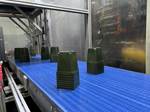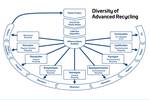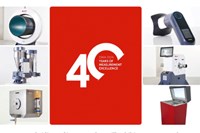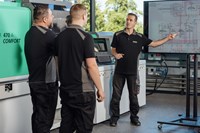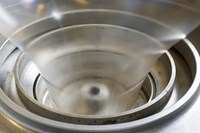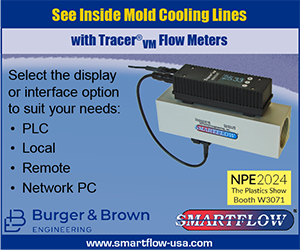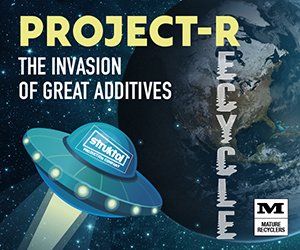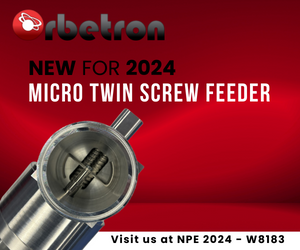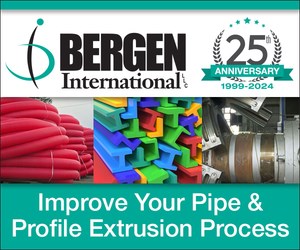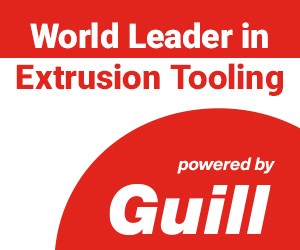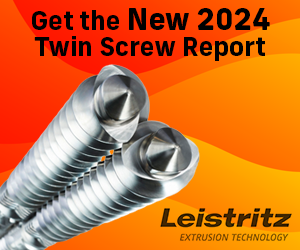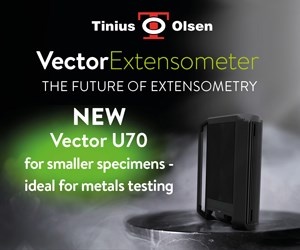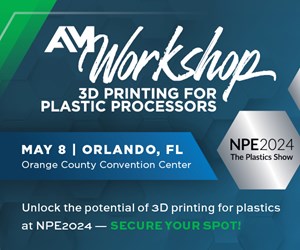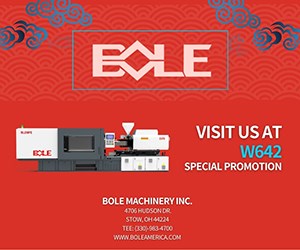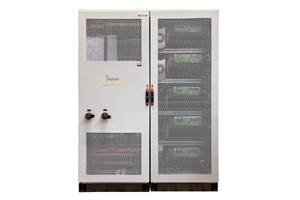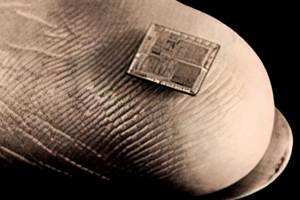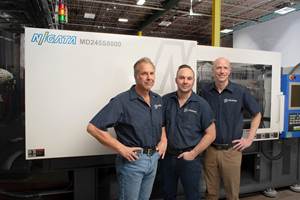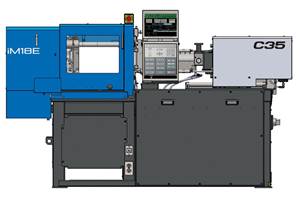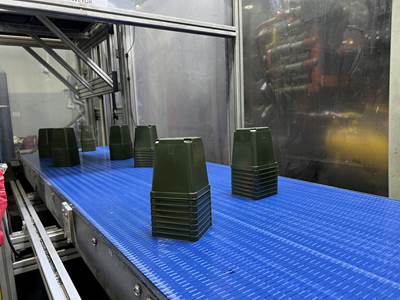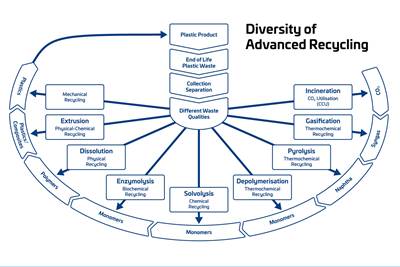Why Five-Axis Cartesian Robots Are a Hit with Molders
Five-axis linear robots are proving to be a cost-effective alternative to six-axis articulated robots in many applications.
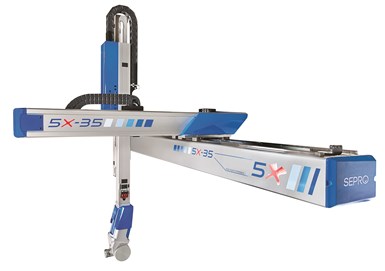
Why is five better than three—or six? When it comes to robot axes of motion, October’s Fakuma 2014 show in Germany provided some answers. Sepro Robotique of France (U.S. office in Warrendale, Pa.) said it has seen sales of five-axis Cartesian robots take off. Such robots are more capable than standard three-axis linear robots and often are a more cost-effective choice than a six-axis articulated robot (which Sepro also offers).
Based on a standard three-axis Cartesian beam robot, Sepro’s 5X line adds a two-axis servo wrist developed in partnership with Staubli Robotics (U.S. office in Duncan,
S.C.). In the two years since the 5X line was introduced at Fakuma 2012, Sepro says sales of these units have grown nine-fold and were expected to double 2013’s sales last year. It is by far the company’s fastest-growing new product line. According to CEO Jean-Michel Renaudeau, “We are seeing molders buying five-axis models even when they don’t have a need for them today, because they expect to in the future.”
IT’S ALL IN THE WRIST
There are several reasons for this popularity:
• Molders increasingly require high accuracy and flexibility in gripping and downstream positioning. Loading multiple inserts at high speeds, or multiple motions to demold complex parts in a tight mold space are facilitated by the extra axes. The same goes for secondary operations like passing the edge of a part past a flaming fixture or placing parts in trays in different positions. And unlike a pneumatic wrist, the servo wrist can grip parts at any angle and perform multiple servo motions in synchronization with other robot movements.
• Another benefit is adaptability to different molds and machines. Ability to reprogram servo motions in software is especially helpful for custom molders dealing with transfer tooling that they did not design, or that must run a given mold in different machines to meet scheduling requirements.
• The servo wrist boasts clean operation, suitable for medical and other applications that cannot tolerate particulates resulting from drive-belt wear or lubricant contamination.
• High accuracy and repeatability are afforded by servo wrist operation with a positional encoder that recognizes exactly where the drive shaft is at any moment. And the system control can integrate positional signals from all of the servo motors on all five axes so that it knows exactly where the gripper and part are in space at all times.
• Many of the complex part manipulation tasks mentioned above have historically been assigned to six-axis articulated-arm robots. But a linear Cartesian robot offers faster access to the mold space and simpler programming.
HOW TO MOLD A CUP FILLED WITH WATER
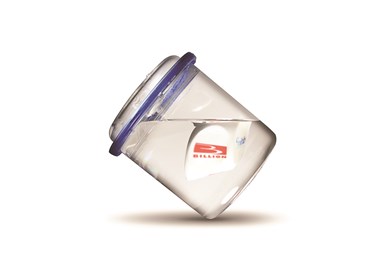
This cup comes out of the mold sealed, filled with water, and with a plastic object bobbing inside. A Sepro 5X robot inserts the floating piece, dispenses the water, and removing the finished part. This involves several lateral motions and two rotations inside the mold area
These capabilities were demonstrated at the booth of Billion, the French injection machine builder, where a Sepro 5X robot was mounted on a Billion Select 200 all-electric two-shot press. This demonstration of in-mold assembly involved multi-shot injection (a Billion specialty) to encapsulate a liquid (water) inside a closed, cup-like container with dice floating inside. The mold, built by MIHB in France,
uses two rotating plates for a multi-step process (see it on YouTube here):
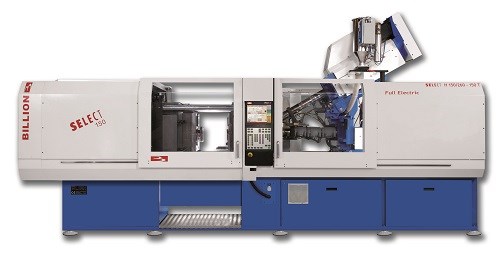
This Billion Select 150T all-electric, two-component press injects clear and colored copolyester to make the cup body and lid.
1. The machine injects the top and bottom of the container on opposite sides of the mold. One of the two rotating plates holds the lid of the cup and a finished part. The other rotating plate holds the body of the cup. One plate nests into the moving half of
the mold and the other into the stationary half, but both are connected by a shaft to the moving half of the mold.
2. The mold opens and the two rotating plates index forward and turn 180° to bring the two parts of the cup in line with each other. One plate retracts again into the stationary mold half, and the Sepro robot descends and removes the finished part and turns 180° to insert the dice into the body of the new cup.
3. The plate holding the bottom half of the cup retracts against the other plate, holding the two parts of the cup together with mild pressure. Meanwhile, the robot turns 90° and moves laterally to insert the end of a long filling nozzle into a hole in the lid of the cup.
Water is dispensed to fill the cup about two-thirds full.
4. The robot retracts and the mold halves clamp together, and the second Billion injection unit overmolds the seam between the cup halves to create a water-tight seal.
5. The mold opens so the finished part can be removed and the cycle repeats.
In this demo, the robot performs multiple functions: inserting the dice, filling the part with water, and removing the finished part. This involves several lateral motions and two rotations inside the mold area.
The material was Eastman’s Tritan clear copolyester for the lid and body, and Tritan with color masterbatch for the overmolded seal.
Related Content
Wittmann Finds Battery Partner for Direct Current (DC) Molding Machine Concept
Displaying the solar-powered press at Fakuma 2023 following its K 2022 debut, Wittmann announced a development partnership with Innovenergy for DC infrastructure.
Read More50 Years...600 Issues...and Still Counting
Matt Naitove marks his first half-century in plastics reporting, with a few of his favorite headlines.
Read MoreCustom Injection Molder Plugs into All Electric Machines
Formerly a showroom for early-aughts-era Van Dorn hydraulics, the newest additions to Drummond Industries’ transforming fleet are all-electric Niigata injection molding machines.
Read MoreCompact Hybrid Injection Molding Machine Launched
Sumitomo Heavy Industries Ltd. (SHI) has introduced the iM18E, promising the smallest footprint in 20-ton machines.
Read MoreRead Next
Processor Turns to AI to Help Keep Machines Humming
At captive processor McConkey, a new generation of artificial intelligence models, highlighted by ChatGPT, is helping it wade through the shortage of skilled labor and keep its production lines churning out good parts.
Read MoreLead the Conversation, Change the Conversation
Coverage of single-use plastics can be both misleading and demoralizing. Here are 10 tips for changing the perception of the plastics industry at your company and in your community.
Read MoreAdvanced Recycling: Beyond Pyrolysis
Consumer-product brand owners increasingly see advanced chemical recycling as a necessary complement to mechanical recycling if they are to meet ambitious goals for a circular economy in the next decade. Dozens of technology providers are developing new technologies to overcome the limitations of existing pyrolysis methods and to commercialize various alternative approaches to chemical recycling of plastics.
Read More

